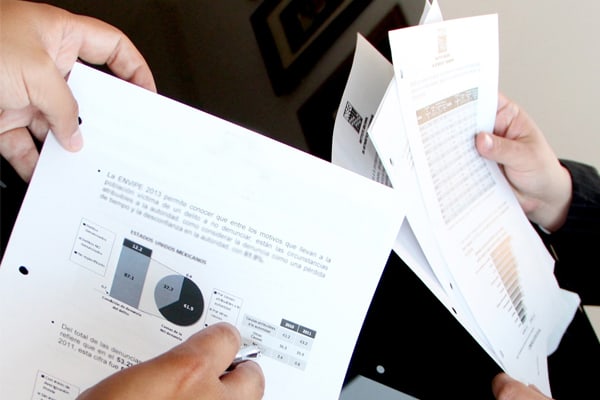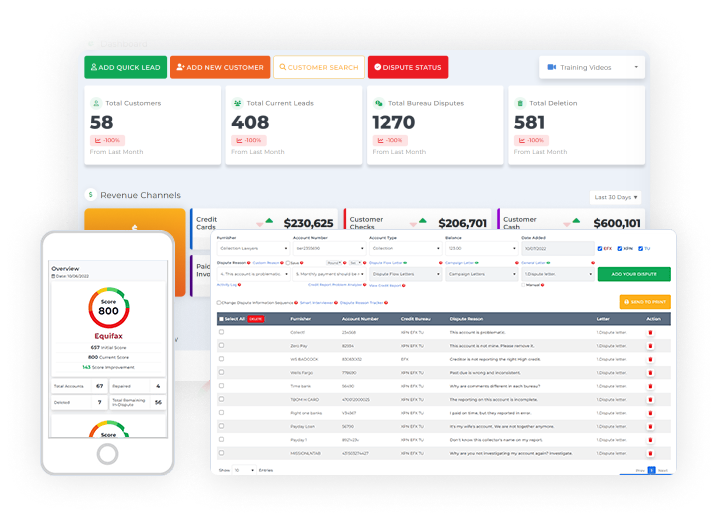Mark Clayborne here from clientdisputemanagersoftware.com. In today’s video, what I want to do is I want to cover five of my secret interviewing tips that I used to use when I was running a Credit Repair Business. That’s right. I wrote down five secret tips that I used to use when I was running a credit score improvement business. Now, I’m going to just be honest with you right here, I did write them down right here on my sheet.
I have a Smart Credit clipboard that they gave me at one of the events, a credit per marketing event. But what I want to do is I want to talk to you guys about the way that I interviewed my customer to get the best results before you start working on their file. So there’s five key secrets that I do or I used to do, and sometimes I do teach this.

And my coaching a one on one coaching program with students, these are the five key things, right? This is what I’ve learned that worked for me and it gave me enough information that I needed, right?
To really help the consumer work on inaccurate accounts. So here’s the five key tips. So you don’t want to miss this. Don’t cut off the video because if you are new to the industry or if you are established in the industry, you could be doing it wrong, right? So these are five key tips.
1. Run A Credit Analysis or A Credit Analyzer
The first thing you want to do very, very, very first thing you want to do is you want to make sure you run a credit analysis or a credit analyzer. Now the client dispute manager software have a credit analyzer function and what is that?
What it does it analyze the credit reports, all three credit monitoring reports and it looks for the inconsistencies on the credit report, right?
It also tells you all the negative items that’s on the credit report. So you want to have… You want to review that and you also want to run a credit analysis and you want to review that as well.
And on top of that, you want to import the customer’s credit report into the software. And once you import that, you want to look at all of the negative information that’s there.
Now you need this information so when you have the conversation with your customer, you can have an intelligent conversation and you don’t want your customer to feel that you don’t know what you’re doing because you didn’t take the time to review their credit report. So that’s the first thing.
2. Schedule An Interview
Number two is you want to schedule this interview by phone or possibly by zoom. Now the reason why I say zoom because you want to make some sort of intimate contact with this customer.

And what I mean by intimate, I don’t mean intimate. I mean you want them to be able to see your face because you are a internet company. Now, if you are a brick and mortar company, that’s one thing.
They can walk into your office and they can see you right there. But if your internet company, you want to be able to see your customer face to face and you want them to be able to see you to build that know, like and trust.
That’s where that know, like and trust come from, right? So the more they see you in person through zoom, the more trust that they have with you. And not only that, if you do it on a zoom video, you also have a recording of your customer giving you all the information that you need regarding the inaccurate accounts on the credit report.
And that’s good for you. That’s good for you to protect you in the long run in case the customer comes back and says, “Hey, I didn’t tell you to dispute that or I didn’t give you that reason for disputing.” You could simply say, “Yes you did.” And we’re talking about factual disputes. So that’s number two.
Now the next thing when it comes to the zoom meetings, is that I will say for example, you decide to do a zoom meeting for your interview. Before you do that zoom meeting first of all, you want to make sure that you’re groomed well.
You want to make sure that your hair is cut well, your hair is done and you want to make sure you have the appropriate clothes on at the time when you do this zoom meeting and not only when you do the zoom meeting, you also want to make sure your background is clean and professional when you do the zoom meeting.

Because this is your customer and you want to represent that your brand is very professional and clean.
3. Make Sure That You Have Your Tools with You
When you do meet the customer, whether it’s over the phone or on a zoom call, you want to make sure that you have your tools with you and your tools are the credit analysis, the credit report if you have it and or the credit analysis. Now you want to make sure you have that.
Now, it really depends on what your business model is, whether you send the credit analysis to them beforehand or not, but it’s really good that you do send the credit analysis or credit analyzer to them beforehand so they can have this in front of them as well. Or you can ask them to log it to their credit monitoring and download their credit report in a PDF format.
So that way you both are on the same page and there’s no misunderstandings because our time is very precious and you don’t want to go over an hour going over inaccurate information with your customer.
So you got them on a phone, you got them on a zoom call and the first thing you want to do is you want to go line by line every single inaccurate negative account pulling the credit report, you want to go line by line with your customer. Now don’t rush this part because this is very important.
so don’t rush to get them off the phone. This is probably the only time you’re going to talk to them in a six month span. So you want to make sure you get this part right, right? Line by line, every single negative item on the credit report, you want to go over it with your customer and you want to go line by line interviewing your customer on each one of those accounts, all right? Each one of those accounts.

Now one of the things you want to do is you want to let the customer free flow and you want to ask them pretty much, “Is there anything wrong with this account?” Now, some of the customers may not know, right?
So you want to ask them to check every element of the account, right? Check the balance, check the date open, the date last reported, is this your account? Is it an authorized user account? Where you really late on that day? So you want to ask them for every element inside of the credit report in these fields because the customer is not as smart as you are when it comes to reading the credit report.
You are the credit score improvement specialist. You are the master at this. So you want to make sure that you help your customer understand the credit report.
Now don’t lead the customer. That’s one thing you don’t want to do. Don’t lead them, but help them understand how to read the credit report because there’s nobody out there helping them understand. I mean did anybody help you understand how to read your credit report? No.
So you had to learn on your own and it’s not that easy to read the credit report and quietly understand what’s going on. So you want to help the customer and just say, “Look, is there anything on this particular account that you feel that’s inaccurate?” And ask them. You can go line by line, ask them.
And then as they talk, you take the notes. As they talk, you take the notes, right? You take the notes, they go, don’t rush them, don’t rush them. Just go line by line and go to the next line and take detailed notes.

Because remember your disputes are based off of your customer’s argument, not off of yours. They’re based off your customers argument. So that’s why it’s so important for you to take the interview. All right, so number four, we talked about taking detailed notes.
So you want to take these detailed notes. Now, if you print out the credit report, another thing you can do something that I forgot, sorry, you can actually print the credit report out yourself and you can have the credit report in front of you. And when I was helping customers improve their credit score, I would have the credit report printed out in front of me along the credit analysis.
And what I would do as we go line by line, I would circle the account and I would actually write on the credit report itself, right?
Those were my notes, my like my cheat sheet. So I would write on the credit report itself and next to each account. So it was very easy for me when I go back into the client dispute manager and I go into the activity log, it’s very easy for me to notate exactly what he or she said for every single account when I’m putting in the activity log. And also it’s a record for you too.
So you have that credit report, you have the notes on that credit report, you have a file for that customer, right? In your office you have a file cabinet for that customer and make sure you get a file cabinet with a lock on it. Always have a file cabinet with a lock or a combination lock, right?
In case somebody breaks into your office or if you have a home office, someone breaks into your home and they steal that data, that’s a problem.

So always make sure you have a file lock on the file account. So what you can do, you print out the credit report and then you have the credit report printed out. And then you can highlight and circle the accounts as the customer goes over each negative account.
All right, and then you would have your own annotated notes on that credit report and you can take that, transfer it to the activity log inside of the software claims view manager software, and then now you have correct and accurate data.
Now not only do you have correct and accurate data, but if you are a large credit repair company and you’re doing a lot of volume and you forget about one customer and they call you up and say, “Hey, what happened? Like in round three what happened to this account?” And you’re like, “Oh, I don’t know, I forgot.”
But if you do a good interview and you take great notes, you will have that information in your activity log and you can easily reference to it very quickly while you have the customer on the phone and you can say, “Oh yeah, I remember you did submit the supporting documentation, for this student loan.”
And number five and the last thing we want to talk about, number five is a supporting documentation. Always ask the customer, “Do you have any supporting documents to support your argument? Do you have any supporting documents to support your argument on why you feel this account is inaccurate?”
You see, we don’t want to just do blind disputes. I’m going to talk to you about that in a few minutes, but you always want to try to get his most as much supporting documentation as you can to support your customers argument when they send this letter to the credit bureaus, because all the credit bureau’s doing is taking your letter along with the supporting documentation and scanning it in and sending it over to the creditor or the collector.

That’s all they’re doing. And then the creditor or the collector, they’re looking at the supporting documentation along with your letter and they’re trying to verify if what you’re saying is correct or not. And then they report back to the credit bureau. And that’s pretty much what’s happening there with the.
Again, let me just recap the five things again, I’m looking at my clipboard from Smart Credit here, review the credit analysis, the credit report, and the analyzer before, before you schedule the interview, schedule your interview by phone or by zoom. Make sure that you have the right background.
If you’re going to do a zoom call, make sure you have the right clothes on. Make sure your groomed up really well.
Number three, when you meet with the customer, go line by line, line by line, step by step, move by move, line by line, right? Line by line. Number four, take really, really, really good notes. Remember I said print out the credit report, circled the account, and just annotate the notes right next to it so you have an understanding.
You’re not confused. You can even upload that credit report into the document section so you can have that as proof that you did do the interview in case you’re ever audited by a regulatory body. And number five, ask for supporting documentation. All right, now this is a bonus training here. This is a bonus.
Now, here’s what we call disputing blind. Now you may ask, “Well, Mark, what happens if I’m playing phone tag with the customer back and forth and I can’t get them on the phone, but they submitted all their other documentations and they’re ready for me to begin?”

Well, what you can do is you don’t ever want to dispute blind. You never want to do that. And what I mean by disputing blind, I mean starting a dispute round without ever interviewing the customer.
Without ever interviewing the customer. That’s what I mean. So if you can’t get the customer, let me give you some ways that you can try to reach out to this customer. One, call them every day, two texts, three Facebook, four email. And lastly, send them a letter in the mail. So you’re going to have to put that account on hold until you can reach the customer.
You’re going to have to put that account on hold until you can reach the customer. How are you going to begin your dispute and do factual disputes if you don’t actually talk to the customer. And that’s what we call disputing blind.
That means you can’t get the customer on the phone, but you want to get started with the customer. So you just go send the first few rounds out without even talking to the customer, you probably don’t want to do that because you’re disputing blind and you haven’t had any communication with the customer at all.
All right, so again, this is Mark Clayborne from clientdisputemanagersoftware.com. I hope you enjoyed this video. If you ever looking for a great software for your credit score improvement business, go to clientdisputemanagersoftware.com. We do have a free trial, 30 day free trial, no credit card required. Come on and join the family. Clientdisputemanagersoftware.com.
Bonus: Now that you have read this article, why not take your new skill and start your own credit business helping others? We have free training that can help you do just that.
Click here to learn more.



